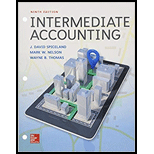
Error correction:
Error correction is an adjustment to previously issued financial statements. It is not considered as an accounting change.
To Journalize: Entry necessary to correct the error, and
Explanation of Solution
| Date | Account Title and Explanation | Debit Amount($) | Credit Amount($) |
| 61,000 | |||
| Interest expense (1) | 61,000 | ||
| (To record error found before adjustment) |
Table (1)
- Retained earnings are component of shareholders’ equity. There is a decrease in the value of shareholders’ equity. Therefore, it is debited.
- Interest expense is a liability. There is an increase in liability value. Therefore, it is credited.
Adjusting entry for the year 2018
| Date | Account Title and Explanation | Debit Amount($) | Credit Amount($) |
| Interest expense (1) | 61,000 | ||
| Discount on bonds payable(2) | 1,000 | ||
| Interest payable(3) | 60,000 | ||
| (To record error discovered before adjustment) |
Table (2)
- Interest expense is a liability. There is a decrease in liability value. Therefore, it is debited.
- Discount on bonds payable and notes payable are liability. There is an increase in liability value. Therefore, it is credited.
- Interest payable is a liability which is increased; hence credit the interest payable.
Journal entries that should have been recorded:
Adjusting entry for the year 2017
| Date | Account Title and Explanation | Debit Amount($) | Credit Amount($) |
| Interest expense(1) | 61,000 | ||
| Discount on bonds payable(2) | 1,000 | ||
| Interest payable(3) | 60,000 | ||
| (To record error discovered before adjustment) |
Table (3)
- Interest expense is a liability. There is a decrease in liability value. Therefore, it is debited.
- Discount on bonds payable and notes payable are liability. There is an increase in liability value. Therefore, it is credited.
- Interest payable is a liability which is increased; hence credit the interest payable.
Journal Entry for the year 2018
Date |
Account Title and Explanation | Debit Amount($) | Credit Amount($) |
| Interest expense(4) | 12,200 | ||
| Interest payable(3) | 60,000 | ||
| Discount on bonds payable(5) | 200 | ||
| Cash(Given) | 72,000 | ||
| (To record the correct entry) |
Table (4)
- Interest expense is a liability. There is a decrease in liability value. Therefore, it is debited.
- Interest payable is a liability which is decreased; hence debit the interest payable.
- Discount on bonds payable is a liability which is increased; hence credit the discount on bonds payable.
- Cash is being paid, cash is an asset which is being decreased; hence credit the cash account.
Working notes:
a. Calculate the interest expense for the year 2017
b. Calculate discount on bonds payable for the year 2017
c. Calculate the interest payable for both the years of 2017 and 2018
d. Calculate the interest expense for the year 2018 up to February 1.
e. Calculate the discount on bonds payable for the year 2018 up to February 1.
Interest expenses of 2018 are overstated by recording extra interest in the month of February. Likewise, retained earnings are overstated by the exact amount as the interest expense of 2017 was understated when the accrued interest was not reported.
Want to see more full solutions like this?
Chapter 20 Solutions
INTERMEDIATE ACCOUNTING(LL)-W/CONNECT
- PLEASE HELParrow_forwardOne company might depreciate a new computer over three years while another company might depreciate the same model computer over five years...and both companies are right. True Falsearrow_forwardno chatgpAccumulated Depreciation will appear as a deduction within the section of the balance sheet labeled as Property, Plant and Equipment. True Falsearrow_forward
- No ai Depreciation Expense is shown on the income statement in order to achieve accounting's matching principle. True Falsearrow_forwardno aiOne company might depreciate a new computer over three years while another company might depreciate the same model computer over five years...and both companies are right. True Falsearrow_forwardno ai An asset's useful life is the same as its physical life? True Falsearrow_forward
- no ai Depreciation Expense reflects an allocation of an asset's original cost rather than an allocation based on the economic value that is being consumed. True Falsearrow_forwardThe purpose of depreciation is to have the balance sheet report the current value of an asset. True Falsearrow_forwardDepreciation Expense shown on a company's income statement must be the same amount as the depreciation expense on the company's income tax return. True Falsearrow_forward
 College Accounting (Book Only): A Career ApproachAccountingISBN:9781337280570Author:Scott, Cathy J.Publisher:South-Western College Pub
College Accounting (Book Only): A Career ApproachAccountingISBN:9781337280570Author:Scott, Cathy J.Publisher:South-Western College Pub
